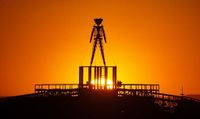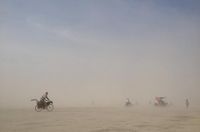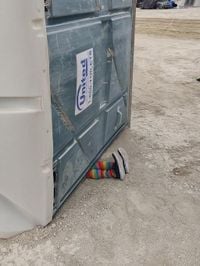Burning Man, the legendary arts and counterculture festival held annually in Nevada’s Black Rock Desert, is no stranger to chaos. But this year, the desert’s notorious weather delivered a particularly dramatic blow: the destruction of the festival’s infamous Orgy Dome, a sex-positive sanctuary that has become one of Burning Man’s most talked-about attractions. The event, which draws about 70,000 attendees each year, was just getting underway when a fierce windstorm swept through Black Rock City, leaving a trail of destruction in its wake and shuttering the Orgy Dome for the remainder of the festival.
The Orgy Dome—a sprawling, air-conditioned tent filled with beds, couches, and mood lighting—has been a fixture at Burning Man since its founding in 2003. Tucked away on a 150-person campsite, and featuring the adjacent Aphrodite’s Garden as a meet-and-greet space, the Dome has provided a safe, consensual, and inclusive environment for couples and moresomes to escape the dust and heat, and to explore intimacy in all its forms. As organizers described on Instagram, “We pride ourselves in creating a sex-positive, consensual space for couples and moresomes to play during their stay at Black Rock City. The Orgy Dome is a safe, inclusionary, and exploratory environment. All couples and moresomes who are adults are welcome in the Dome – straight, lesbian, gay, bi, polyamorous and monogamous. We welcome the combination of love in all forms.”
But on Saturday, August 23, 2025, disaster struck. Hurricane-force winds—gusting up to 50 miles per hour—whipped across the playa, sending massive dust clouds swirling and toppling even the sturdiest structures. According to the San Francisco Chronicle, at least four people suffered minor injuries from flying debris and collapsing tents. The Orgy Dome’s fate was sealed as the storm battered its metal poles, swept away its roof, tore off its outer siding, and left its beds scattered and missing. In a somber post on social media, the Orgy Dome’s organizers shared a video of the wreckage, writing, “Our build team worked so hard this past week to erect our lovely space. Unfortunately, the winds yesterday undid all that labor and wrecked our structure. We are still here and thankfully safe, we hope to gift the playa some workshops and will keep you updated.”
The devastation was not limited to the Orgy Dome. The same storm also destroyed several other installations, including Black Cloud, a 50-foot tall inflatable sculpture created by Ukrainian artists as a symbol of freedom and a warning about the dangers of potential global conflict. In a press release, the creators of Black Cloud explained, “After 5:30 p.m. [on Aug. 24] a sudden hurricane-force wind swept across the desert. Despite the calculations, the installation withstood only the first fifteen minutes. A powerful gust tore the structure apart from within, and the storm destroyed Black Cloud completely.” Vitaliy Deynega, the general producer of Black Cloud, added on Facebook, “It held against the wind for the first fifteen minutes, and then tore apart in the middle—the storm burst inside and destroyed it completely.”
For festivalgoers, the storm created immediate, tangible challenges. Campsites were upended, belongings lost, and incoming Burners found themselves stuck in traffic jams lasting up to eight hours. Burning Man organizers responded by closing the gates to Black Rock City on Sunday night, August 24, preventing entry or exit until the worst of the storm had passed. Flights were also halted, and all attendees were strongly urged to stay off the roads. The gates finally reopened early Monday morning, August 25, with weary but determined festivalgoers rising early to repair their camps and retrieve lost items.
The loss of the Orgy Dome struck a particularly poignant chord among regulars. Last year alone, the Dome reportedly welcomed more than 5,000 visitors, with long lines forming outside as people waited their turn to experience what has become an iconic part of the Burning Man landscape. The Dome’s sex-positive ethos, focus on consent education, and climate-controlled comfort offered a rare oasis amid the harsh desert environment. As one organizer emphasized, the Dome was “an intimate safe space” where the importance of consent was promoted “beyond intimate space.”
Despite the destruction, the Dome’s team has not given up on its mission. Organizers promised to continue offering workshops and events on the Playa, even as the main structure lay in ruins. They called upon attendees to donate any equipment—ball bungees, zippers, or other supplies—that might help prop up the tent for the remainder of the festival. Messages of support poured in on social media, with neighboring camps offering everything from cold craft brews to helping hands for the volunteers who had worked tirelessly to build the Dome.
This year’s storm is just the latest in a string of extreme weather events to hit Burning Man. In 2022, festivalgoers endured scorching temperatures that soared to 106 degrees Fahrenheit, making it the hottest Burning Man on record for many. The following year, nearly an inch of rain fell, turning the playa into thick mud and prompting a no-driving order that stranded thousands. This year, in addition to the windstorm, the forecast for Tuesday, August 26, predicted a 51% chance of rain and thunderstorms, further complicating matters for those already struggling to recover from the storm’s aftermath. Road closures in nearby Nixon, more than 70 miles from the festival site, threatened to cut off access and delay travel to Black Rock City.
Even with these challenges, the spirit of Burning Man seems undiminished. Attendance for the 2025 event has remained strong, peaking around 70,000 despite the inhospitable conditions. The festival, which runs through September 1, continues to attract a devoted following drawn by its ethos of radical self-expression, communal effort, and creative experimentation. As always, the unpredictable desert remains both a crucible and a proving ground for those willing to brave its extremes.
For now, those seeking the unique camaraderie and exploration once found within the Orgy Dome will have to look elsewhere—or perhaps find new ways to connect on the Playa. Organizers remain hopeful, vowing to keep the spirit of inclusion and consent alive, even without their iconic tent. As the dust settles and the festival marches on, the story of the Orgy Dome’s destruction becomes yet another chapter in the ongoing saga of Burning Man—a place where nothing is permanent, and everything is possible.


